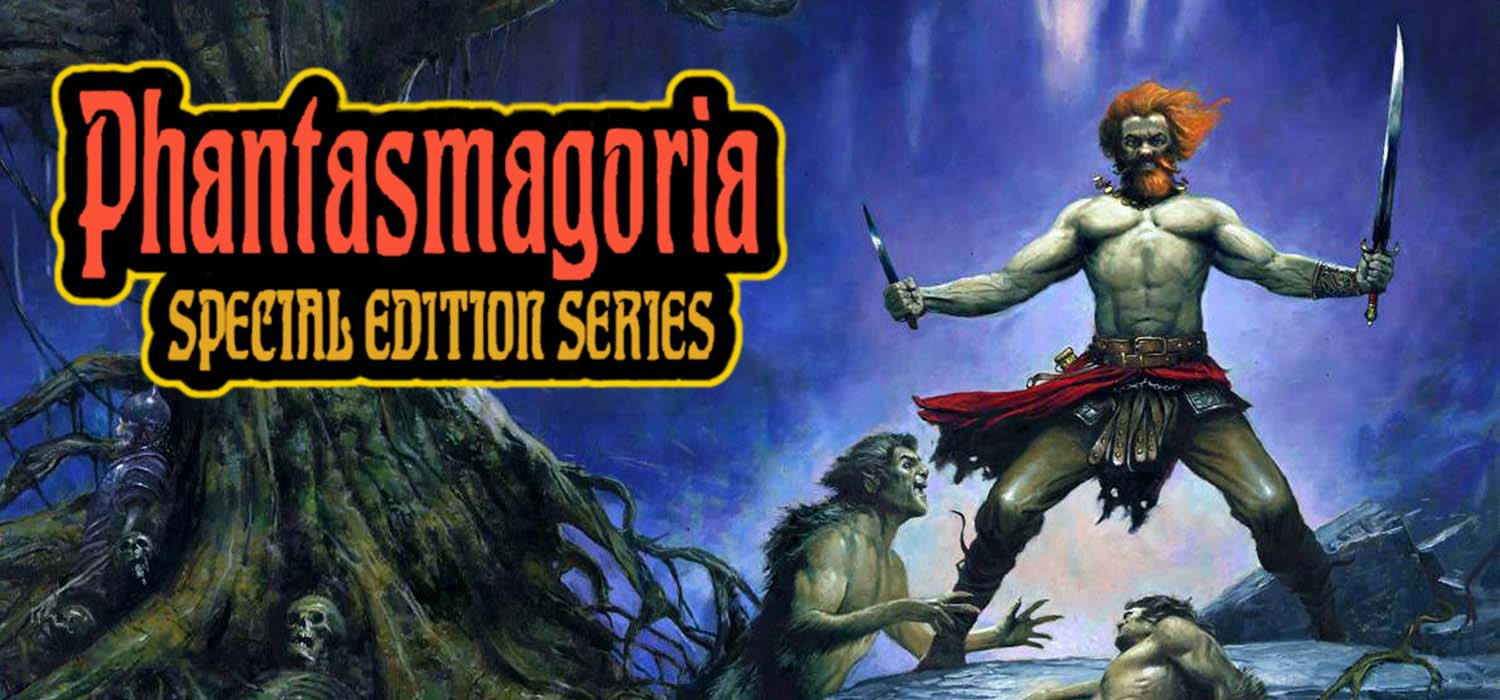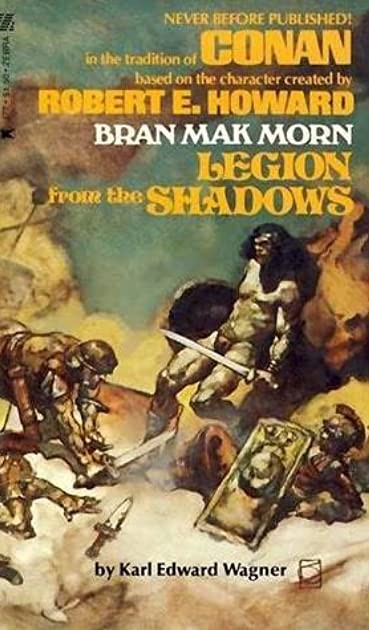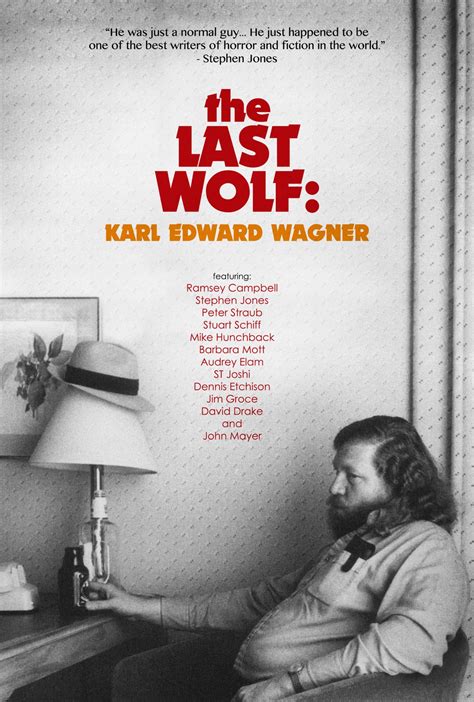Karl Edward Wagner's Kane
Apr 24, 2022 3:12:52 GMT -5
Post by Deleted on Apr 24, 2022 3:12:52 GMT -5
In the video from my previous post Michael mentions the Phantasmagoria Special Edition: Karl Edward Wagner. Here's an interesting article from Goodman Games by Brian Murphy (Flame and Crimson: A History of Sword-and-Sorcery):

Preserving the Flame: A Review of Phantasmagoria Special Edition Series #5: Karl Edward Wagner
What makes Karl Edward Wagner’s best writing so powerful? I believe he was chasing a dark muse, dangerous and unpredictable, vital and vivid. The one we see on the page of “Into the Pines,” a story which alone makes the new Phantasmagoria Special Edition Series#5: Karl Edward Wagner, worth its price tag: Out into the pines Renee led him. The pines whose incessant whisper told of black knowledge and secret loneliness.
Wagner to me seems to have harbored a secret loneliness, and possessed an uncomfortable insight into the human condition that possibly contributed to his well-documented struggles with addiction. While it’s too tempting to associate an artist with their art, and sometimes a mistake to correlate the two, Wagner’s numerous conflicted and tortured protagonists make it difficult to entirely disassociate his fiction from the events of his personal life. His stories are populated with writers struggling with fickle markets, bad marriages, and alcoholism, leading to torment and ruin, and cursed hero-villains, seeking a solace which forever eludes their grasp. But during his too-short life, Wagner for a time was able to harness his dark muse and create works of lasting potency.

Wagner’s stories are getting harder to find, although his Kane material at least is available in ebook format. I worry at times that he may slip into obscurity, though he has a hardcore following among sword-and-sorcery and horror aficionados in the know, while a few corners of the web keep his guttering flame alive. This new issue of Phantasmagoria adds to that bulwark.
If you’re a fan of Wagner you need this volume in your collection. It’s an intriguing blend of remembrance and reminiscence by those who knew him, insightful essays about his works, fiction that he either wrote or curated during his editorship of the DAW Year’s Best Horror stories, and other valuable miscellanea. The list of contributors is impressive, with contributions by the likes of Ramsey Campbell, S.T. Joshi, Stephen Jones, and David Schow. It’s laced with intriguing nuggets and scraps that, stitched together, help shed light on an author still lacking a proper biography. Here’s a few that resonated with me:
Though at times he dismisses the term, Wagner referred to Kane as a “swords and sorcery hero.” A minor point, but perhaps surprising to some of his protective fanbase who have sought to dissociate him from a style of fiction they deem disreputable. As it turns out, Wagner himself used the term, on a few occasions in documented interviews.
An image of the cover of the promised but unpublished second Bran Mak Morn pastiche, Queen of the Night, which Wagner’s friend and Carcosa publishing partner David Drake says was never written. It appears it was not, as the manuscript has to my knowledge never surfaced.
A tantalizing comment that Putnam had planned to issue three more Wagner-edited Conan editions. It’s a shame these never materialized, if only for Wagner’s introductions alone. The book is loaded with such comments about Wagner works that he planned but never wrote, including the rumored Kane novel In the Wake of the Night.
Insight into the formation of Carcosa press, which Wagner says sprang from a desire to carry on the tradition of high-quality editions of weird fiction August Derleth published at Arkham House.
Wagner’s thoughts on the possibility of a Kane film, and who would be best cast the role of the red-haired, blue eyed, cursed immortal. Wagner was partial to the late William Smith.
Roger Zelazny performed an audio recording of Night Winds, published on two cassettes in 1993. This was news to me (and so intriguing that I must find it, and a working tape player).

The book contains much more than just dry factoids, however intriguing, about Wagner. One of my favorite entries was “Dave Carson’s Thrilling Wagner Tales.” Here Carson, an award-winning illustrator, offers up a rambling, alcohol-soaked but moving account of wandering the streets and pubs of London with his friend, drinking and quoting The Wild Bunch, a favorite film of Wagner’s.
We also get some of Wagner’s fiction, including the Kane story “Sing a Last Song of Valdese” and one of his best horror stories, “In the Pines.” The latter led me on a merry Youtube chase to Nirvana’s terrific unplugged live version of the song. Also included were a handful of non-Wagner horror stories, which he curated for Year’s Best Horror and so give some insight into the type of fiction he favored. Each of these entries includes a brief introduction by Wagner or some words about him by the author.
There are also some solid critical essays and reviews. Steve Dilks’ entry, “Shades and Reflections: An Appreciation of Karl Edward Wagner’s Kane,” spends some welcome space covering the later and more experimental Kane stories, including the likes of “At First Just Ghostly.” Because Kane was immortal Wagner could have spun stories of Kane in our times or the future. Dilks speculates on what might have been for the character, or still could be, if a new anthology of writers were permitted to continue the character with original pastiche stories. “Who wouldn’t want to see Kane as a hell-raising biker leading a band of Angels against the corporate establishment of a New World Order as the world sinks into the mire of social unrest and barbarism?” Dilks asks. Count me in.
Adrian Cole of Elak and The Dream Lords fame takes an in-depth look at Legion from the Shadows and Wagner’s depiction of the Picts in “Karl Mac Morn.” Cole sees Legion from the Shadows as worthy of Howard, some historical anachronisms aside, summing up of the 1977 effort: “Ultimately, I think Wagner did a damn good job on Legion from the Shadows, never mind the lapses. I talked to him once about his Conan and Bran pastiches and he said they were difficult to get right because, simply, he wasn’t Robert E. Howard and no one could write like him. Then again, no one writes quite like Karl Edward Wagner. He was a force of nature, maybe an anachronism himself, fighting wars he could not win and which in the end defeated him, ironically as they had defeated Howard. Both men were unique, lonely and irreplaceable.”

I also appreciated a lengthy interview with the makers of the recent Wagner documentary The Last Wolf. This piece added a lot to the experience of watching the film, and how much of a true labor of love it was. It took some three years to make, on a budget so low it’s not even a shoestring ($1,000), by two filmmakers with no real experience in the craft—but crucially, equipped with the desire to do its subject justice, learn as they went along, and see it through to completion. I’m glad they persisted because the film is excellent.
There is much more to recommend this volume of Phantasmagoria, including heartfelt essays by the likes of his lifelong friends and correspondents Stephen Jones and John Mayer. There are many wonderful photographs of Karl throughout, and some stunning artwork by the likes of Carson, Jones, and Jim Pitts. An interview with David Drake was quite terse and short on insight and detail, possibly because of Drake’s current ill-health. It was one of the book’s few disappointments.
Help keep Wagner’s legacy alive by adding this volume to your library. Kudos to editor Trevor Kennedy for putting it together.
Source:
goodman-games.com/blog/2021/12/10/preserving-the-flame-a-review-of-phantasmagoria-special-edition-series-5-karl-edward-wagner/
Amazon Links for the Phantasmagoria Special Edition: Karl Edward Wagner:
www.amazon.co.uk/Phantasmagoria-Special-Karl-Edward-Wagner/dp/B09KN81HJ8
www.amazon.com/Phantasmagoria-Special-Karl-Edward-Wagner/dp/B09KN81HJ8

Preserving the Flame: A Review of Phantasmagoria Special Edition Series #5: Karl Edward Wagner
What makes Karl Edward Wagner’s best writing so powerful? I believe he was chasing a dark muse, dangerous and unpredictable, vital and vivid. The one we see on the page of “Into the Pines,” a story which alone makes the new Phantasmagoria Special Edition Series#5: Karl Edward Wagner, worth its price tag: Out into the pines Renee led him. The pines whose incessant whisper told of black knowledge and secret loneliness.
Wagner to me seems to have harbored a secret loneliness, and possessed an uncomfortable insight into the human condition that possibly contributed to his well-documented struggles with addiction. While it’s too tempting to associate an artist with their art, and sometimes a mistake to correlate the two, Wagner’s numerous conflicted and tortured protagonists make it difficult to entirely disassociate his fiction from the events of his personal life. His stories are populated with writers struggling with fickle markets, bad marriages, and alcoholism, leading to torment and ruin, and cursed hero-villains, seeking a solace which forever eludes their grasp. But during his too-short life, Wagner for a time was able to harness his dark muse and create works of lasting potency.

Wagner’s stories are getting harder to find, although his Kane material at least is available in ebook format. I worry at times that he may slip into obscurity, though he has a hardcore following among sword-and-sorcery and horror aficionados in the know, while a few corners of the web keep his guttering flame alive. This new issue of Phantasmagoria adds to that bulwark.
If you’re a fan of Wagner you need this volume in your collection. It’s an intriguing blend of remembrance and reminiscence by those who knew him, insightful essays about his works, fiction that he either wrote or curated during his editorship of the DAW Year’s Best Horror stories, and other valuable miscellanea. The list of contributors is impressive, with contributions by the likes of Ramsey Campbell, S.T. Joshi, Stephen Jones, and David Schow. It’s laced with intriguing nuggets and scraps that, stitched together, help shed light on an author still lacking a proper biography. Here’s a few that resonated with me:
Though at times he dismisses the term, Wagner referred to Kane as a “swords and sorcery hero.” A minor point, but perhaps surprising to some of his protective fanbase who have sought to dissociate him from a style of fiction they deem disreputable. As it turns out, Wagner himself used the term, on a few occasions in documented interviews.
An image of the cover of the promised but unpublished second Bran Mak Morn pastiche, Queen of the Night, which Wagner’s friend and Carcosa publishing partner David Drake says was never written. It appears it was not, as the manuscript has to my knowledge never surfaced.
A tantalizing comment that Putnam had planned to issue three more Wagner-edited Conan editions. It’s a shame these never materialized, if only for Wagner’s introductions alone. The book is loaded with such comments about Wagner works that he planned but never wrote, including the rumored Kane novel In the Wake of the Night.
Insight into the formation of Carcosa press, which Wagner says sprang from a desire to carry on the tradition of high-quality editions of weird fiction August Derleth published at Arkham House.
Wagner’s thoughts on the possibility of a Kane film, and who would be best cast the role of the red-haired, blue eyed, cursed immortal. Wagner was partial to the late William Smith.
Roger Zelazny performed an audio recording of Night Winds, published on two cassettes in 1993. This was news to me (and so intriguing that I must find it, and a working tape player).

The book contains much more than just dry factoids, however intriguing, about Wagner. One of my favorite entries was “Dave Carson’s Thrilling Wagner Tales.” Here Carson, an award-winning illustrator, offers up a rambling, alcohol-soaked but moving account of wandering the streets and pubs of London with his friend, drinking and quoting The Wild Bunch, a favorite film of Wagner’s.
We also get some of Wagner’s fiction, including the Kane story “Sing a Last Song of Valdese” and one of his best horror stories, “In the Pines.” The latter led me on a merry Youtube chase to Nirvana’s terrific unplugged live version of the song. Also included were a handful of non-Wagner horror stories, which he curated for Year’s Best Horror and so give some insight into the type of fiction he favored. Each of these entries includes a brief introduction by Wagner or some words about him by the author.
There are also some solid critical essays and reviews. Steve Dilks’ entry, “Shades and Reflections: An Appreciation of Karl Edward Wagner’s Kane,” spends some welcome space covering the later and more experimental Kane stories, including the likes of “At First Just Ghostly.” Because Kane was immortal Wagner could have spun stories of Kane in our times or the future. Dilks speculates on what might have been for the character, or still could be, if a new anthology of writers were permitted to continue the character with original pastiche stories. “Who wouldn’t want to see Kane as a hell-raising biker leading a band of Angels against the corporate establishment of a New World Order as the world sinks into the mire of social unrest and barbarism?” Dilks asks. Count me in.
Adrian Cole of Elak and The Dream Lords fame takes an in-depth look at Legion from the Shadows and Wagner’s depiction of the Picts in “Karl Mac Morn.” Cole sees Legion from the Shadows as worthy of Howard, some historical anachronisms aside, summing up of the 1977 effort: “Ultimately, I think Wagner did a damn good job on Legion from the Shadows, never mind the lapses. I talked to him once about his Conan and Bran pastiches and he said they were difficult to get right because, simply, he wasn’t Robert E. Howard and no one could write like him. Then again, no one writes quite like Karl Edward Wagner. He was a force of nature, maybe an anachronism himself, fighting wars he could not win and which in the end defeated him, ironically as they had defeated Howard. Both men were unique, lonely and irreplaceable.”

I also appreciated a lengthy interview with the makers of the recent Wagner documentary The Last Wolf. This piece added a lot to the experience of watching the film, and how much of a true labor of love it was. It took some three years to make, on a budget so low it’s not even a shoestring ($1,000), by two filmmakers with no real experience in the craft—but crucially, equipped with the desire to do its subject justice, learn as they went along, and see it through to completion. I’m glad they persisted because the film is excellent.
There is much more to recommend this volume of Phantasmagoria, including heartfelt essays by the likes of his lifelong friends and correspondents Stephen Jones and John Mayer. There are many wonderful photographs of Karl throughout, and some stunning artwork by the likes of Carson, Jones, and Jim Pitts. An interview with David Drake was quite terse and short on insight and detail, possibly because of Drake’s current ill-health. It was one of the book’s few disappointments.
Help keep Wagner’s legacy alive by adding this volume to your library. Kudos to editor Trevor Kennedy for putting it together.
Source:
goodman-games.com/blog/2021/12/10/preserving-the-flame-a-review-of-phantasmagoria-special-edition-series-5-karl-edward-wagner/
Amazon Links for the Phantasmagoria Special Edition: Karl Edward Wagner:
www.amazon.co.uk/Phantasmagoria-Special-Karl-Edward-Wagner/dp/B09KN81HJ8
www.amazon.com/Phantasmagoria-Special-Karl-Edward-Wagner/dp/B09KN81HJ8

